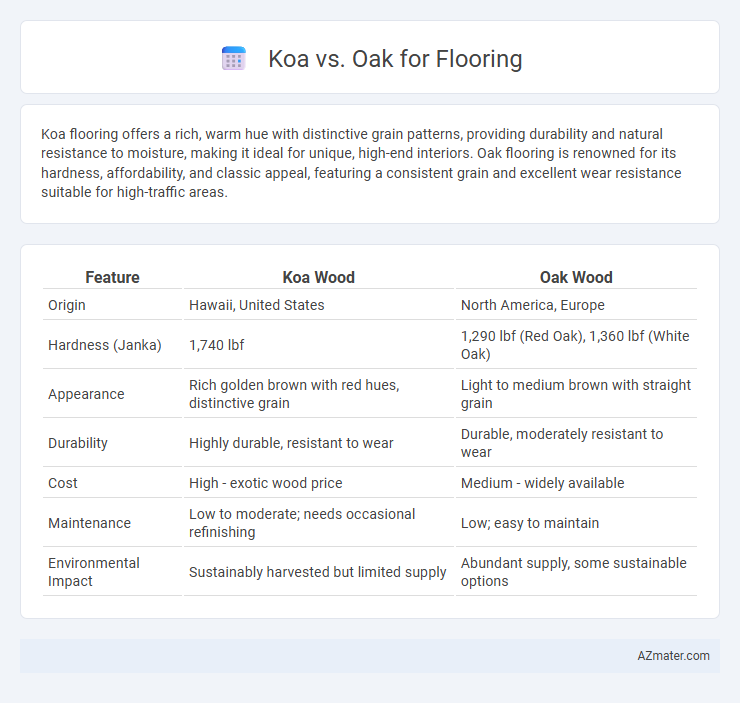Koa flooring offers a rich, warm hue with distinctive grain patterns, providing durability and natural resistance to moisture, making it ideal for unique, high-end interiors. Oak flooring is renowned for its hardness, affordability, and classic appeal, featuring a consistent grain and excellent wear resistance suitable for high-traffic areas.
Table of Comparison
| Feature | Koa Wood | Oak Wood |
|---|---|---|
| Origin | Hawaii, United States | North America, Europe |
| Hardness (Janka) | 1,740 lbf | 1,290 lbf (Red Oak), 1,360 lbf (White Oak) |
| Appearance | Rich golden brown with red hues, distinctive grain | Light to medium brown with straight grain |
| Durability | Highly durable, resistant to wear | Durable, moderately resistant to wear |
| Cost | High - exotic wood price | Medium - widely available |
| Maintenance | Low to moderate; needs occasional refinishing | Low; easy to maintain |
| Environmental Impact | Sustainably harvested but limited supply | Abundant supply, some sustainable options |
Introduction to Koa and Oak Flooring
Koa flooring, derived from the Acacia koa tree native to Hawaii, showcases a rich, warm hue with striking grain patterns that enhance interior aesthetics. Oak flooring, sourced primarily from North American and European oak species, is renowned for its durability, versatility, and classic appeal with prominent grain texture. Both Koa and Oak offer distinct natural hardwood flooring options, with Koa prized for its exotic look and Oak favored for its robust performance and wide availability.
Origins and Availability of Koa vs Oak
Koa wood, native to Hawaii, is prized for its rich, warm hues and unique grain patterns, making it a rare and exotic flooring choice primarily sourced from limited Hawaiian forests. In contrast, Oak, widely available in both red and white varieties, originates from extensive forests across North America and Europe, offering greater accessibility and variety for flooring projects. The distinct origins of Koa and Oak significantly influence their availability, with Oak being more cost-effective and easier to obtain than the premium-priced Koa flooring.
Appearance and Aesthetic Differences
Koa flooring showcases rich, golden to reddish-brown hues with distinctive swirling grain patterns that add warmth and exotic appeal to interiors. Oak flooring presents a more neutral palette ranging from light beige to medium brown, featuring straight, prominent grain lines that suit traditional and contemporary styles. Koa's unique figure and vibrant color make it ideal for statement spaces, while oak's versatility and subtle texture provide a timeless aesthetic for varied design schemes.
Durability and Hardness Comparison
Koa flooring offers superior hardness, ranking around 1,200 on the Janka hardness scale, making it more resistant to dents and scratches compared to Oak, which typically scores between 1,200 and 1,360 depending on the species. Koa's dense, tight grain structure enhances its durability and longevity in high-traffic areas, while Oak, especially Red Oak, provides balanced hardness with better flexibility and shock resistance. For long-term flooring durability, Koa's hardness makes it an excellent choice in environments prone to heavy use, whereas Oak remains popular for its classic look and reliable toughness.
Cost and Value Analysis
Koa flooring typically commands a higher price due to its rarity, rich grain, and deep color, offering exceptional durability and a luxurious aesthetic that enhances property value. Oak flooring, available in red and white varieties, is more affordable and widely accessible, providing robust hardness and versatile styles that suit various budgets without compromising durability. Evaluating cost versus long-term value, koa appeals to premium market segments seeking exclusivity, while oak delivers reliable performance and classic appeal for cost-conscious consumers.
Environmental Impact and Sustainability
Koa flooring, derived from native Hawaiian trees, offers a highly sustainable option due to its fast growth and responsible harvesting practices that support reforestation efforts. Oak flooring, while durable and widely available, often involves slower-growing trees, raising concerns about deforestation and longer replenishment cycles. Choosing koa promotes biodiversity and reduces carbon footprint, making it a more environmentally friendly choice compared to traditional oak flooring.
Installation and Maintenance Needs
Koa flooring offers a smooth installation process with tongue-and-groove planks that fit snugly, reducing gaps and easing maintenance through its natural resistance to moisture and scratches. Oak flooring requires more precise acclimation and subfloor preparation during installation to prevent warping, but its dense grain pattern makes it durable and easier to refinish over time. Both woods benefit from periodic cleaning and protective finishes, though Koa's tropical hardness may demand less frequent upkeep compared to traditional oak species.
Versatility in Home Design
Koa offers rich, warm tones and a unique grain pattern, making it highly versatile for both traditional and modern flooring designs. Oak's durability and neutral color palette complement a wide range of interior styles, from rustic to contemporary, enhancing home aesthetics effortlessly. Both woods provide adaptable flooring solutions that seamlessly integrate with diverse home decor themes.
Pros and Cons: Koa vs Oak Flooring
Koa flooring offers a rich, warm appearance with unique grain patterns and excellent durability, making it prized for its natural beauty and resistance to wear. Oak flooring, particularly red and white oak, is highly durable, cost-effective, and widely available, featuring consistent grain that suits various design styles. While Koa tends to be more expensive and less common, its exotic appeal contrasts with oak's versatility and ease of maintenance, making each suitable for different aesthetic and budget preferences.
Which Flooring Should You Choose?
Koa flooring offers a rich, warm hue with unique grain patterns, providing a luxurious and exotic appeal ideal for upscale interiors. Oak flooring, known for its durability and classic aesthetic, presents a versatile option with natural resistance to wear and a variety of stain finishes. Choosing between Koa and Oak depends on your preference for either distinctive elegance or enduring practicality in high-traffic areas.

Infographic: Koa vs Oak for Flooring
 azmater.com
azmater.com